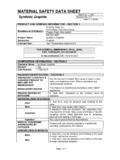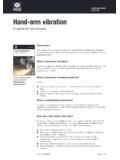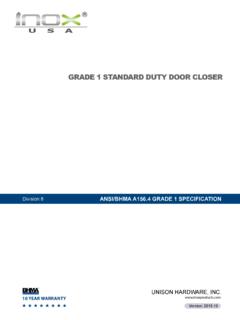Transcription of Health and Safety Laboratory Buxton Derbyshire SK17 9JN
1 Health and Safety Laboratory Harpur Hill Buxton Derbyshire SK17 9JN. Hand- arm vibration emission of chainsaws . comparison with vibration exposure. HSL/2004/13. Project Leader: Paul Pitts Author(s): Paul Pitts BSc(hons) MIOA. Science Group: Human Factors Group Crown copyright 2004. PRIVACY MARKING: Available to anyone This report and the work it describes were undertaken by the Health and Safety Laboratory under contract to the Forestry Commission. Its contents, including any opinions and/or conclusions expressed or recommendations made, do not necessarily reflect policy or views of the Health and Safety Executive.
2 HSL report approval: Dr L Kenny Date of issue: July 2004. Job number: JC4500006. Registry file: NV/07/2002/21089. Electronic filename: Report final RESTRICTED: COMMERCIAL. iii iv CONTENTS. 1 INTRODUCTION 1. Background 1. Objectives 1. Project Plan 2. 2 STUDY METHODS 3. Chainsaws 3. ISO 7505 tests 3. Hand- arm vibration forest measurements 3. Exposure time studies 6. 3 RESULTS 9. ISO 7505 tests 9. Hand- arm vibration forest measurements 9. Exposure time Studies 10. Estimations of daily vibration exposures 12. Differences in daily exposure estimates 25. 4 DISCUSSION 29. ISO 7505 test results 29. Exposure times 31. In-Forest vibration values 32.
3 Ranking of chainsaws 32. Methods of estimating daily vibration exposure 34. Simplified exposure estimation 35. Example of the use of the simplified exposure estimation method 35. Recommendations on the use of the simplified estimation method 36. 5 CONCLUSIONS 37. Emission test results 37. In-forest test results 37. Simplifcations of exposure based on published Emission values 37. 6 ACKNOWLEDGEMENTS 38. 7 REFERENCES 39. 8 GLOSSARY 40. ANNEX A CHAINSAW DETAILS 42. Saw A 42. Saw B 42. v Saw C 42. Saw D 42. Saw E 43. ANNEX B HAND- arm vibration FOREST MEASUREMENTS 44. Sample of analysis showing detail of frequency analysis 44.
4 Summary of vibration total values from in-forest measurements 45. ANNEX C PREDICTION OF EMISSION VALUES 50. Prediction of vibration emission values from in-forest data 50. ANNEX D STATISTICAL ANALYSIS OF SAW MODE DIFFERENCES 51. Forest activity modes 51. INDEX TO TABLES AND FIGURES 53. vi EXECUTIVE SUMMARY. BACKGROUND. The manufacturer's declared vibration emission of a hand held power tool should be related to the vibration magnitude a h . Unfortunately, for many tool types the relationship is poor and the vibration emission should not be used as a substitute for the in-use vibration magnitude. However, evidence from previous HSL studies suggests that for chain saws there is a usable relationship between emission and exposure.
5 vibration exposure is highly dependent on exposure times. These will vary from job to job. To simplify the estimation procedure, it may be possible to take into account typical exposure times for a range of common activities. At its simplest, the estimation procedure could use a simple multiplication factor for converting from vibration emission to a daily vibration exposure, with tables of constants provided for standard job types. OBJECTIVES. The objective of this project was to establish whether it is feasible to produce simplified methods for estimating daily vibration exposures based on hand- arm vibration emission data provided by the saw manufacturers.
6 MAIN FINDINGS. 1. All the manufacturer's published emission values were verified according to the definition in EN 12096. 2. For the in-forest measurements, the results from saws A, B and D were shown to be not statistically significantly different and saw E (the top-handled saw) and Saw C show as being statistically different from the other saws. 3. Ranking test showed that Saw E is the lowest- vibration saw and saw C is the highest, the others share equal ranking. 4. For all forest operations, except arboriculture and cross cutting, daily exposure consistently exceed the m/s A(8) exposure action value (EAV) defined in the EU Physical Agents ( vibration ) Directive.
7 In four cases the daily exposure limit value (ELV) of 5 m/s A(8) is exceeded, these are all for the use of saw C. 5. There is some scope for simplif ication of exposure assessment, using nominal exposure times for job categories, rather than exact exposure times. 6. A table of multiplying values has been produced. This can be used for converting emission values to exposure estimates for the eight job categories seen in this study. Use of this table has been shown to result in errors in daily exposure estimates in the range from 34% to +46% when used with published emission data. 7. The use of the simplified exposure assessment methods, based on published ISO 7505 data, might usefully be used as a first stage vibration exposure assessment, to provide an indication of likely exposure, but should not be used as evidence that exposure is below an EAV or ELV, particularly where the predicted exposure value is close to the EAV or ELV.
8 Vii 1 INTRODUCTION. BACKGROUND. Manufacturers and suppliers of hand held power tools, such as chain saws, are required to provide information on hand- arm vibration emission. For chain saws the vibration emission values are derived from an ISO Standard test ISO 7505: 1986 Forestry machinery - Chain saws - Measurement of hand-transmitted vibration . The users, and employers of users of handheld power tools need to assess the risk from vibration resulting from the use of those tools. A European Directive on Physical Agents ( vibration ) published in July 2002 will result in the introduction of new UK legislation on hand- arm vibration exposure in 2005.
9 The new legislation will place duties on employers based on an exposure action value for daily vibration exposure of m/s A(8) and an exposure limit value of 5 m/s A(8). The assessment of hand- arm vibration exposure is based on ISO standard ISO 5349-1:2000. Mechanical vibration - Measurement and evaluation of human exposure to hand-transmitted vibration - Part 1: General requirements . This standard assesses hand- arm vibration exposure in terms of a daily exposure value, normalised to 8 hours, the A(8) value. This value is dependent on both vibration magnitude a h and exposure time, t. For use of a single power tool: A(8 ) = a hv T.
10 EightHours The vibration emission of a hand held power tool should be related to the vibration magnitude a h . Unfortunately, for many tool types the relationship is poor and the vibration emission should not be used as a substitute for the in-use vibration magnitude. However, there is some evidence (Pitts et al 1990) that for chain saws there is a usable relationship between emission and exposure. OBJECTIVES. The objective of this project was to establish whether it is feasible to produce simplified methods for estimating daily vibration exposures based on hand- arm vibration emission data provided by the saw manufacturers.















